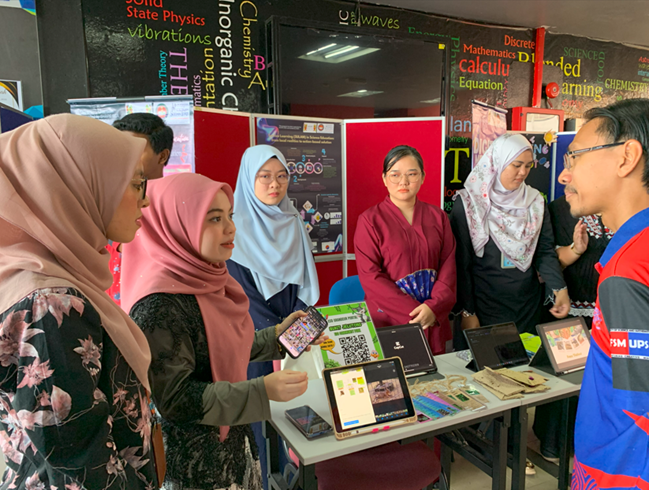Lasers, transistors, and LEDs are some of the inventions based on quantum physics that have widespread applications and have profoundly transformed the lives of modern society. As the building blocks of computing devices shrunk to microns and nanometer scales, digital information technology acquired increased storage capacity and computing/processing power.
Portable optoelectronic devices like handphones and tablets, and distanced communication through a global network of wireless electromagnetic fields and fiber optics became accessible to everyone. These advances have loaded us with a huge amount of digital information (big data and 5G), driving the economy and businesses and triggering the 4th industrial revolution (4IR). These technologies are based on the fundamental knowledge of electrons, atoms, photons, and their interactions that can only be described by quantum mechanics. But that is not all quantum physics can offer.
Two quantum physics concepts are at the heart of quantum technology behind the coming quantum revolution. Quantum superposition is where a quantum bit or particle can assume any combination of several quantum states simultaneously, in contrast to the usual bits of only 0 and 1. Secondly, a particle’s quantum state can instantaneously affect another distanced particle’s state via quantum entanglement. Sound spooky?
These concepts are used to assemble a sufficiently large number of quantum bits to build quantum computers that can perform multitasking, parallel and simultaneous information processing. Information search can proceed in parallel by searching everywhere for an answer “at once” and getting the answer within seconds without going through multiple sequential searches. The same concept enables quantum computers to perform mathematical feats like factorisation of large numbers at a much faster speed than a supercomputer, therefore able to break all existing encryptions or passwords within a practically short period, posing a threat to information security, particularly financial and banking corporations.
The next quantum revolution is already here now! Scientists worldwide compete to harness “entanglement” for disruptive applications and compete for information and computing supremacy. The race to develop quantum technology is between the United States, China and Europe. China launched a quantum satellite in August 2016 and has been developing a big plan to connect their cities with quantum networks. The United Kingdom government invested €370 million in December 2013 in quantum technologies for the next 5 years. The European Commission followed the step in 2016 and invested €1 billion for 10 years. In December 2018, the United States Senate passed the National Quantum Initiative, which authorized $1.275 billion over five years for quantum information science research and education.
Quantum technology has also caught the attention of big industrial players. Companies like IBM, Google, D-Wave, and Alibaba have invested heavily in developing quantum computers with remarkable capabilities that conventional computers do not have. The eavesdropping incident by Edward Snowden, a former National Security Agency contractor, has alerted the world to the vulnerability of current cryptography technology.
Quantum cryptography is a proven technique that promises secure transmission of confidential information, such as passwords encrypted as “keys” in quantum bits by teleportation of quantum states (but not matter). The technology is (unconditionally) secure because it can detect the presence of eavesdropping. It is continuously being perfected to be robust against any potential hacking, even by quantum computers, thus enabling highly confidential data to be communicated with peace of mind. The current initiative is to extend the secure communication distance beyond hundreds of kilometres via fibre optics to establish a regional-scale quantum network and quantum internet. A long-distance quantum communication network promises secure intercity links between government agencies and financial hubs. Boosting cybersecurity is becoming more important than ever due to the increasing reliance on online communications for work and businesses since the COVID-19 pandemic and the significant rise in cybersecurity threats, as reported in The Star on 12 April 2020.
Researchers from several local universities are teaming up to develop in-house quantum communication technology (QCT) for affordable and high-security quantum networks. The initiative aligns with the National Cyber Security Policy (NCSP) and would benefit the government, academia, industries, society and the environment. It is important to give Malaysia greater self-reliance and control of our defence and national security.
Another class of applications of quantum physics, besides quantum computing and quantum communication, is quantum metrology, which provides new modes of measurements, sensing, and imaging with unprecedented levels of spatial and temporal resolution precision. In particular, it enhances the precision of our current time and frequency standards, used to calibrate our clocks and GPS, ultra-sensitive gravity sensors that enable us to map distributions of underground masses and minerals, and sensors that can detect ultra-weak magnetic fields of the brain offer new medical diagnostic tools. The promising feats of quantum physics, from theory to applications in modern information technology, are exciting developments that should not be missed.
Professor Dr Raymond Ooi obtained his Dr.rer.nat (PhD) from Universitaet Konstanz, Germany. In 2003, he worked with the prominent Professor Marlan Scully at Texas A&M University, a renowned quantum optics and laser physics guru. He was a regular Visiting Scientist at Princeton University and Max-Planck Institut fuer Quantenoptik. In 2006, he joined KAIST as a Research Professor and then Korea University as Assistant Professor. He joined Universiti Malaya in 2010. He started the “Quantum and Laser Science” research group equipped with a femtosecond laser optics lab under the support of a high impact research grant.





